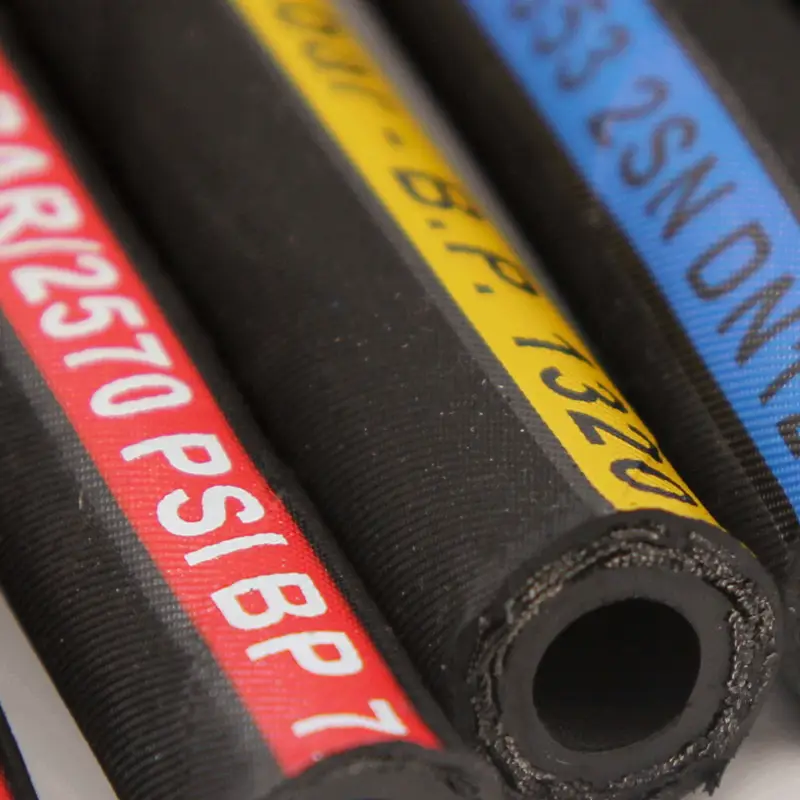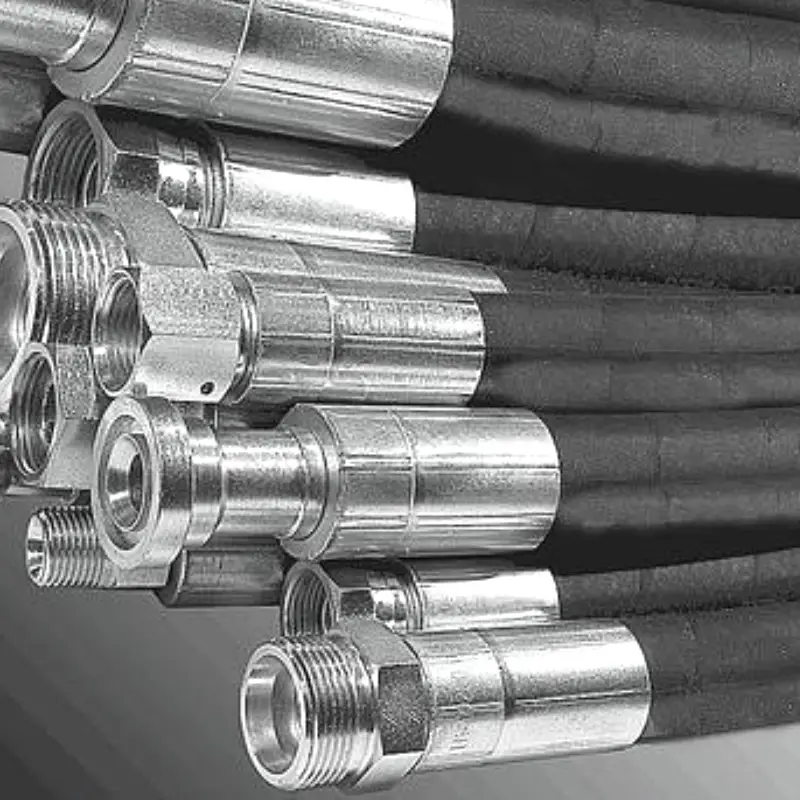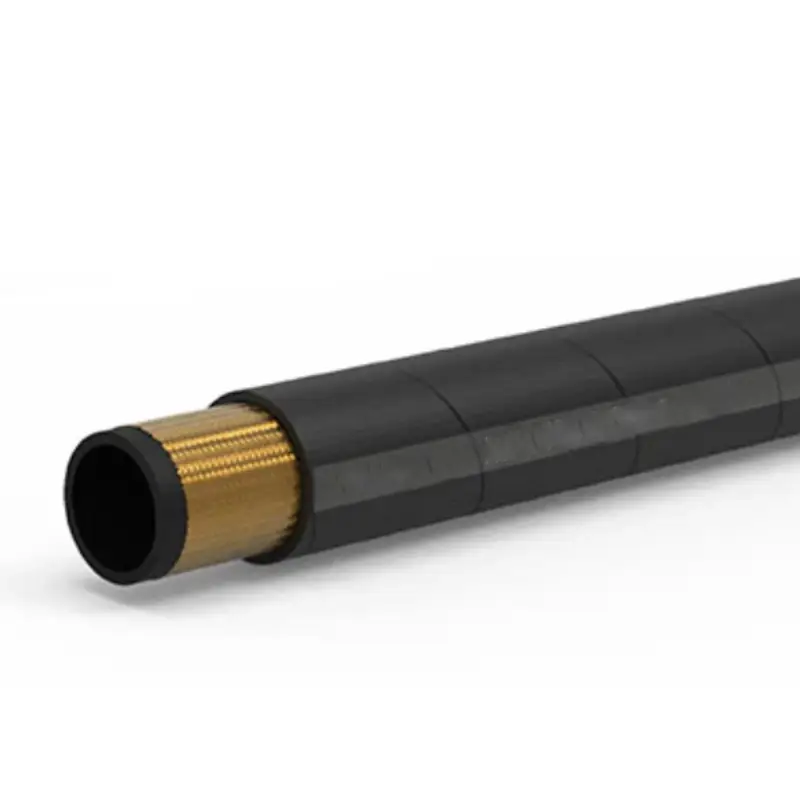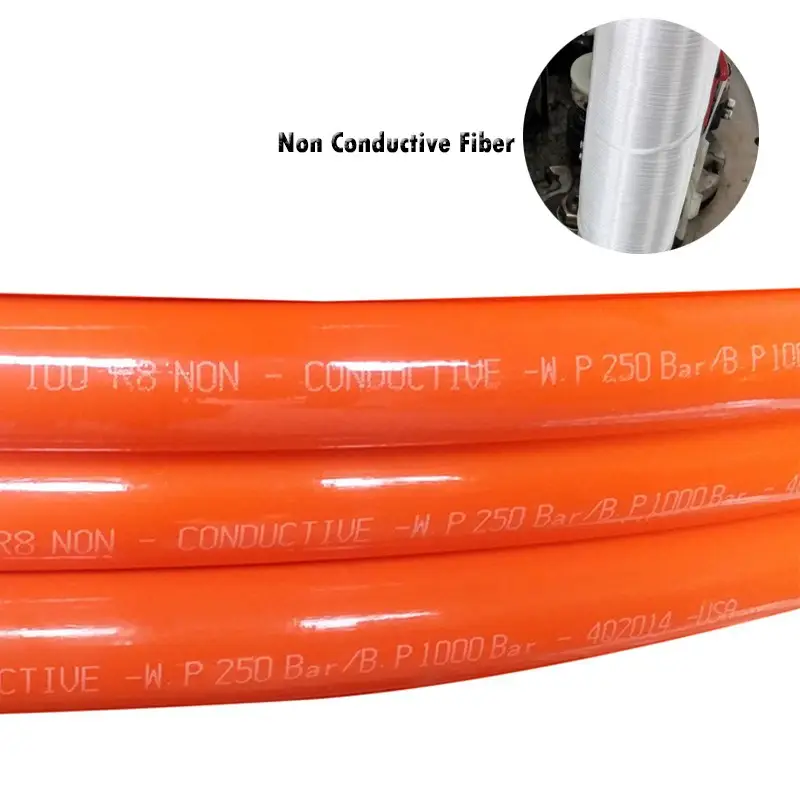Kingdaflex offers a comprehensive range of hydraulic cylinder hoses, engineered for durability and high-pressure performance. Our hoses, manufactured to SAE and DIN standards, ensure reliable power transmission for heavy machinery and industrial applications. We provide various sizes and specifications to meet diverse requirements, ensuring optimal functionality and longevity in your hydraulic systems.
We allow you to choose from various material compositions for your hose’s inner tube, reinforcement, and cover. This includes options for enhanced abrasion resistance, chemical compatibility, or high-temperature resilience. We guide you in selecting materials that best suit your operating environment and the type of hydraulic fluid used.
We provide a wide array of end fitting options, including different connection styles (e.g., JIC, NPT, ORFS) and thread types. This ensures seamless integration with your existing hydraulic components, preventing leaks and simplifying installation. Our team ensures the correct fitting for your specific cylinder and manifold connections.
We can customize the hose’s pressure rating to match your system’s maximum operating pressure, ensuring safety and preventing premature failure. Furthermore, we offer a range of internal diameters to optimize fluid flow and minimize pressure drops. This precision ensures your cylinders receive the exact hydraulic power required.
We precisely cut hoses to your exact required length, eliminating excess material and ensuring a neat, efficient setup. Additionally, we consider the minimum bend radius necessary for your application, preventing kinking and ensuring proper fluid flow even in confined spaces. This customization optimizes hose routing and longevity.

We provide high-pressure hydraulic cylinder hoses engineered to withstand extreme operating pressures. These hoses feature multiple layers of reinforcement, ensuring superior burst strength and longevity in heavy-duty applications. Ideal for large machinery and industrial systems where robust power transmission is critical.

We offer abrasion-resistant hydraulic cylinder hoses with specialized outer covers that resist wear and tear from friction and external damage. Perfect for applications in harsh environments where hoses might rub against machinery or rough surfaces, these hoses significantly extend service life.

We provide temperature-resistant hydraulic cylinder hoses capable of operating in extreme hot or cold conditions. These hoses utilize specific elastomer compounds to maintain flexibility and integrity across a wide temperature range, ensuring consistent performance in demanding thermal environments.

We offer compact hydraulic cylinder hoses designed for installations with limited space. These hoses feature a smaller bend radius and outer diameter without compromising pressure capabilities. They are ideal for intricate machinery designs where routing flexibility and space-saving are paramount.

We provide non-conductive hydraulic cylinder hoses specifically designed for applications where electrical isolation is critical. These hoses prevent electrical conductivity, enhancing safety for operators and protecting sensitive electronic components in proximity to the hydraulic system.
In the field a hydraulic hose, a “cylinder” refers to the hydraulic cylinder itself, which is a mechanical actuator that converts hydraulic energy (pressurized fluid) into linear mechanical force and motion.
The hydraulic hose acts as the crucial conduit, transporting the pressurized hydraulic fluid from a pump or valve to the hydraulic cylinder’s ports. This fluid then acts on a piston inside the cylinder, causing the piston rod to extend or retract, thereby performing work such as lifting, pushing, or pulling in various machinery and industrial applications. The hose is essentially the “vein” that supplies the power to the “muscle” (the cylinder).
The hydraulic hose and hydraulic cylinder are interdependent components that form the core of many hydraulic systems, working in tandem to translate fluid power into mechanical motion.
Hydraulic Cylinder: This is the actuator, essentially a “muscle” that converts the pressure of hydraulic fluid into linear force and motion. It consists of a barrel, a piston, and a piston rod. When pressurized fluid enters one end, it pushes the piston, causing the rod to extend or retract, thereby performing work like lifting, pushing, or pulling.
Hydraulic Hose: These are the flexible “veins” or conduits that transport the high-pressure hydraulic fluid between various components of the system, such as the pump, valves, and the hydraulic cylinder itself. They are crucial for transmitting power, accommodating movement between parts, absorbing vibrations, and allowing for flexible routing in machinery where rigid piping is impractical.
Hydraulic cylinder hose connections are critical for the proper functioning and safety of any hydraulic system. These connections, often referred to as hydraulic fittings, are the specialized components that securely attach a hydraulic hose to the ports of a hydraulic cylinder, as well as to other system elements like pumps and valves.
Their primary role is to create a leak-free seal capable of withstanding the high pressures and vibrations inherent in hydraulic applications, ensuring efficient power transmission and preventing fluid loss.
There are various types of hydraulic cylinder hose connections, each designed with specific sealing mechanisms and applications in mind:
O-Ring Face Seal (ORFS) Fittings: These fittings feature an O-ring at the flat face of the fitting. The O-ring is compressed against a mating flat surface on the cylinder port, creating a highly reliable and leak-free seal, even in high-pressure and high-vibration environments.
JIC (Joint Industry Council) Fittings: JIC fittings utilize a 37-degree flared seating surface. The seal is formed by the metal-to-metal contact between the flared end of the hose fitting and a coned seat on the cylinder port. They are known for their ease of assembly and disassembly.
NPT (National Pipe Tapered) Fittings: Commonly found in North America, NPT fittings use tapered threads that deform upon tightening to create a seal directly within the threads. While widely used and cost-effective, they are generally less suitable for high-pressure or frequently disassembled connections compared to ORFS or JIC.
BSP (British Standard Pipe) Fittings: These fittings come in parallel (BSPP) and tapered (BSPT) thread variations, similar to NPT but with different thread angles and pitches. They are common in many parts of the world and rely on thread deformation or an O-ring/bonded seal for connection.
Flange Fittings (e.g., SAE 4-Bolt Flange): Primarily used for larger diameter hoses and high-pressure applications, flange fittings distribute clamping force over a wider area, providing a very robust and secure connection. They involve a flange bolted onto a mating surface on the cylinder.
Metric Fittings (e.g., DIN): Prevalent in Europe, these fittings often feature specific metric thread types and sealing cones or O-ring designs, conforming to German Industrial Standards (DIN) for various hydraulic applications.
Quick Disconnect Couplings: While not always direct cylinder connections, these are valuable for applications requiring frequent, tool-free hose connections and disconnections. They allow for rapid changes in setup and often incorporate self-sealing valves to minimize fluid loss.
Hydraulic cylinder hoses are indispensable in a vast array of industries and applications where linear force and controlled motion are required.
They serve as the vital link that delivers pressurized fluid to hydraulic cylinders, enabling them to perform work.
Here’s where you’ll commonly find hydraulic cylinder hoses in use:
Construction: Heavy equipment like excavators, bulldozers, cranes, loaders, and backhoes extensively utilize hydraulic cylinder hoses to power their booms, arms, buckets, and outriggers for digging, lifting, pushing, and pulling.
Agriculture: In farming, hydraulic cylinder hoses are essential for machinery such as tractors, harvesters, planters, and sprayers. They control implements like plows, loaders, and various attachments, crucial for tasks from tilling to harvesting.
Manufacturing and Industrial Automation: Hydraulic cylinder hoses are integral to presses, injection molding machines, assembly lines, and robotic arms, where they enable precise movements for tasks like stamping, cutting, clamping, and material handling.
Mining: In the demanding mining sector, hydraulic cylinder hoses power heavy machinery like drill rigs, hydraulic shovels, and rock breakers, enduring harsh conditions while facilitating excavation and material handling.
Transportation and Automotive: You’ll find hydraulic cylinder hoses in vehicle braking systems, power steering, suspension systems, and in specialized transportation equipment like dump trucks (for lifting the bed) and garbage trucks (for compacting waste and lifting mechanisms).
Marine and Offshore: For shipbuilding, offshore drilling platforms, and port equipment, hydraulic cylinder hoses are used in cranes, winches, steering systems, and lifting mechanisms, often requiring resistance to corrosive saltwater environments.
Material Handling: Equipment such as forklifts, scissor lifts, and conveyor systems rely on hydraulic cylinder hoses for lifting, lowering, and positioning heavy loads in warehouses, distribution centers, and manufacturing plants.
Aerospace: In aircraft, hydraulic cylinder hoses are critical for operating landing gear, flight control surfaces (ailerons, flaps, rudders), and braking systems, where reliability and precision are paramount.
Essentially, any application where robust, controlled linear movement is achieved through hydraulic cylinders will depend on high-quality hydraulic cylinder hoses to deliver the necessary power.